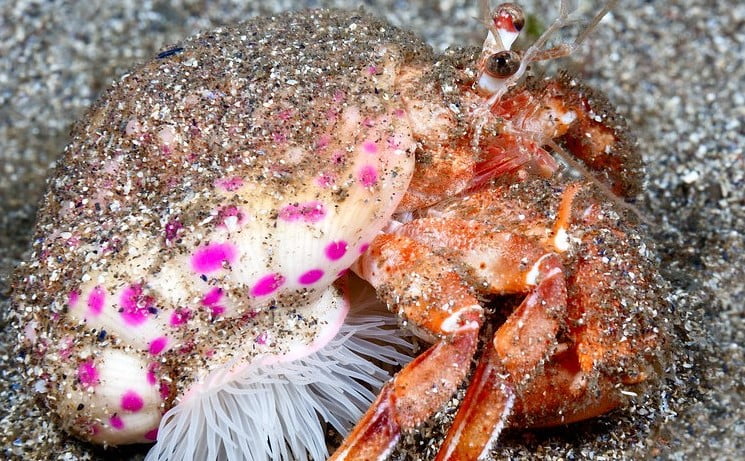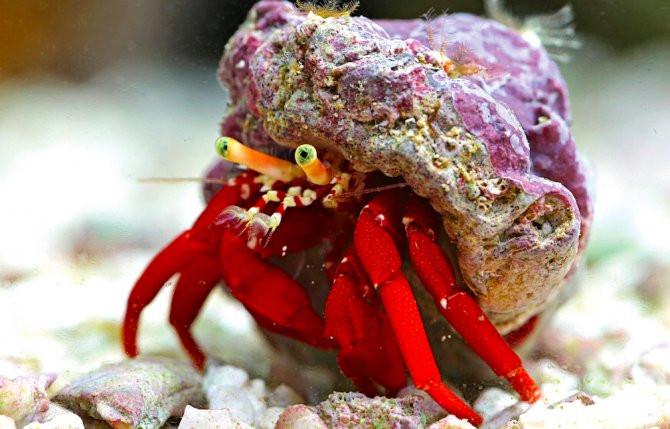There are around 800 species of hermit crabs but all of them are not available as pets. Few are too large to fit in a tank like coconut crabs and giant hermit crabs, most of them are nearly impossible to find and some are heavily exploited by the ornamental pet industry.
Here we’ll talk about some most popular easy to care and vibrant-colored hermit crabs that are safe as pets and will be a great addition to your tank. We’ll dive into both terrestrial and marine hermit crabs.
Electric blue hermit crab

Electric blue hermit crab also known as elegant hermit crab (Calcinus elegans). This is a type of marine hermit crab that plays the role of the cleaning crew in the aquarium. The crab resembles the color of electric blue mixed with orange and black which gives them a striking appearance and they are very easy to care for.
Anemone hermit crab

Many hermit crab species have a relationship with sea anemones but anemone hermit crabs (Dardanus pedunculatus) especially have a symbiotic relationship with sea anemones which makes them one of the attractive hermit crabs. They deal with anemones to place on the shell for protection purposes in return anemones will get a scrap of food and free travel.
Ecuadorian hermit crab

The Ecuadorian hermit crab scientifically known as Coenobita compressus is one of the popular land/terrestrial hermit crab species that can be found in a wide range of habitats like Peru, Ecuador, and Mexico. They can vary from different shades of orange and golden to dark gray. The availability of this crab makes it more popular.
Scarlet hermit crab

The scarlet hermit crab Paguristes cadenati, also known as reef hermit crab, a saltwater crab is renowned for its ornamental red appearance with orange ocular peduncles (eye antenna). They do not like typical gastropod shells that other hermits prefer, they like heavy, gnarly and beat-up shells which makes them different than other hermit crabs.
Viola hermit crab
The viola hermit crab, Coenobita violascens is an underrated land hermit crab species. Usually, the land hermits are more popular than the marines but you will find fewer people talk about this crab. They come in orange, red and brown color but as they grow the color turns into blue and violet. They can live up to 10 years and can be a great addition to your crabitat.
Blue leg hermit crab
Blue leg hermit crab, Clibanarius tricolor also known as the equal handed hermit crab, is one of the small marine hermit crab species. The vibrant orange, blue and black give them an aesthetic appearance and crab enthusiasts love that. Most of the time they are preferred as clean-up crew in the tank and the unique thing they have is their both claws are equal which most hermit crabs do not have.
Strawberry hermit crab

Strawberry hermit crab, Coenobita perlatus is one of the top 2 or 3 popular land hermit crab. They resemble the color and texture of strawberries where the name came from. The availability and low maintenance make it the first choice for crab owners. They can live 25 years+ in the wild, in captivity they can live up to 5 years.
Halloween hermit crab
Ciliopagurus strigatus or the Halloween hermit crab also known as the orange lagged hermit crab or stripped hermit crab, is a spooky crab that comes in bright orange with yellow stripes. The bright vibrant color is eye-appealing in the aquarium and also this is algae cleaner in the tank. For these reasons, many pet crab owners love the Halloween hermit crab.
Zebra hermit crab
The zebra hermit crab, Calcinus laevimanus. also known as left handed hermit crab. Though it is a small crab that can grow up to 1.5 inches, they have a very large left claw. When they are threatened by predators they go back into their shells and block the entrance with the large left claw. Besides they have different color patterns making them a unique hermit crab species.
Red tip hermit crab
This is also a marine hermit crab scientifically known as Clibanarious digueti. This crab barely reaches up to one inch meaning they can go into the corners and eat algae keeping the tank clean. This crab also has the ability to control small sea anemones. They will eat the feces of fish and leftover foods and decayed matter living at the bottom of the tank.
Blueberry hermit crab

Blueberry hermit crab or Okinawa blueberry hermit crab scientifically known as Coenobita pupureus, is a land hermit crab species from Japan. This is very rare and hard to find outside of Japan because it can only be found there. Yet this is a popular species for its blueberry like appearance. But most probably you can not have this crab.
Ruggie hermit crab
Ruggie hermit crab scientifically known as coenobita rugosus is a terrestrial crab species that can commonly be found in the sandy, dune, and mangrove areas of Southeast Asia like Taiwan, Japan, Malaysia, and the Philippines. They have a variety of colors including tan, green, brown, black, white pink and blue. This crab can be differentiated by looking at the stitches mark on their pincer.
Polka dot hermit crab
The polka dot hermit crab Phimochirus operculatus also known as polka dot reef hermit is one of the coolest reef safe hermit crabs considered. When they retract into the shell and close the opening with a bigger claw, gives the appearance of a snail inside. They get their name from the beautiful pattern on their leg. An interesting fact is – this crab is the least shy crab among all of the hermit crab species.
Purple pincher
Finally, the most popular crab the purple pincher aka Caribbean hermit crab is a species of land hermit crab widely known for their distinctive purple claw. They are native to the West Atlantic southern Florida and the Caribbean Sea and are considered great tree climbers.
